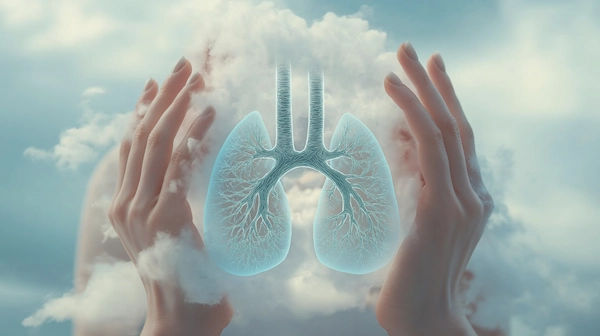Guide to Lung Health Awareness
Learn how to protect your lungs and improve your respiratory health. This comprehensive guide covers key topics, from common lung diseases to preventative tips and lifestyle changes.

Written by Dr. Dhankecha Mayank Dineshbhai
Reviewed by Dr. Rohinipriyanka Pondugula MBBS
Last updated on 25th Sep, 2025

Introduction
Every breath you take is a testament to the incredible work of your lungs. These vital organs operate tirelessly, delivering life-sustaining oxygen to your body and removing waste carbon dioxide. Yet, we often take our lung health for granted until a problem arises. This guide is designed to change that. Raising awareness about how your lungs function, the threats they face, and the steps you can take to protect them is the first step toward a healthier, more vibrant life. Whether you're a former smoker, live in a city, or simply want to optimize your well-being, understanding lung health is crucial. In this article, we will explore the mechanics of your respiratory system, identify common diseases, highlight warning signs, and provide actionable strategies to strengthen your lungs and breathe easier for years to come.
Why Your Lungs are Vital for Overall Health?
Your lungs are the gateway between your body and the air you breathe. Their primary role is gas exchange, a deceptively simple term for a complex and essential process. But their importance extends far beyond just breathing.
The Mechanics of Breathing: More Than Just In and Out
Breathing is an orchestrated effort involving your diaphragm, rib cage muscles, and airways. When you inhale, your diaphragm contracts and flattens, creating a vacuum that pulls air rich in oxygen through your windpipe (trachea). The trachea branches into smaller tubes called bronchi, which further divide into thousands of tiny bronchioles. At the end of these bronchioles are clusters of tiny air sacs called alveoli. This is where the magic happens. Each lung contains millions of alveoli, creating a massive surface area for gas exchange—equivalent to the size of a tennis court! Oxygen diffuses through the alveolar walls into the bloodstream, while carbon dioxide moves from the blood into the alveoli to be exhaled.
The Lungs' Role in Immunity and Oxygenation
Beyond gas exchange, your respiratory system is a key player in your immune defense. The airways are lined with tiny hair-like structures called cilia and a layer of sticky mucus. This mucociliary escalator traps dust, germs, and pollutants, moving them upward to be coughed or sneezed out, preventing them from reaching the delicate lung tissue. Furthermore, the oxygen absorbed by the lungs is fuel for every cell in your body. Optimal lung health ensures your brain, heart, and muscles receive the oxygen they need to function at their best, directly impacting your energy levels, cognitive function, and physical endurance.
Consult Top Specialists
Common Threats to Lung Health
Understanding what harms your lungs is the first step in protecting them. These threats range from personal habits to environmental factors.
Smoking and Vaping: The Primary Adversaries
Tobacco smoke contains over 7,000 chemicals, hundreds of which are toxic and about 70 that can cause cancer. Smoking paralyzes the cilia, damages the alveoli, and causes inflammation, leading to conditions like COPD and lung cancer. While often marketed as a safer alternative, vaping is not harmless. E-cigarette aerosol can contain harmful substances like nicotine, heavy metals, and flavorings linked to serious lung disease. Quitting smoking is the single most important thing you can do for your lung health.
Environmental and Occupational Hazards
We can't always control the air we breathe, but we can be aware of the risks.
Outdoor Air Pollution
Vehicle emissions, industrial smoke, and particulate matter (PM2.5) can irritate the airways, exacerbate asthma, and increase the risk of respiratory infections and long-term damage. Checking daily air quality indexes and avoiding strenuous outdoor activities on high-pollution days can help reduce indoor air pollution exposure.
Indoor Air Pollutants
Indoor air can be more polluted than outdoor air. Common culprits include secondhand smoke, radon gas, mold, pet dander, and volatile organic compounds (VOCs) from cleaning products and air fresheners. Improving ventilation and using air purifiers can significantly improve indoor air quality.
Respiratory Infections and Their Long-Term Impact
Infections like influenza, COVID-19, and pneumonia can cause significant inflammation and damage to lung tissue. While most people recover fully, severe infections can lead to lasting scarring (fibrosis) and a permanent decline in pulmonary function. This underscores the importance of prevention through vaccination, good hand hygiene, and avoiding close contact with sick individuals.
Recognizing the Warning Signs
Your body often sends signals when something is wrong with your lungs. Learning to recognize these signs is crucial for early detection.
Symptoms You Should Never Ignore
A persistent cough that lasts for more than a month, coughing up blood, shortness of breath (dyspnea) during routine activities, wheezing, and chronic chest pain are all red flags. Other symptoms like unexplained weight loss or persistent fatigue can also be associated with serious lung conditions. If symptoms like a chronic cough or shortness of breath persist beyond two weeks, consult a doctor online with Apollo 24|7 for further evaluation.
The Importance of Early Detection
Many lung diseases, including lung cancer and COPD, are most treatable in their early stages. Unfortunately, symptoms often don't appear until the disease is advanced. For high-risk individuals (like long-term smokers), screening with low-dose CT scans can detect lung cancer early, significantly improving survival rates. Listening to your body and reporting changes to a healthcare professional promptly can make a life-saving difference.
Proactive Steps for Healthy Lungs
The good news is that you have significant power to protect and even improve lung capacity naturally.
Lifestyle Choices that Make a Difference
The Power of Regular Physical Activity
Exercise is like a tune-up for your lungs. It makes your heart and lungs work harder to supply the extra oxygen your muscles demand. Over time, this strengthens your respiratory muscles and improves the efficiency of gas exchange. Aerobic activities like brisk walking, swimming, and cycling are excellent for lung health.
Nutrition for Respiratory Wellness
A diet rich in antioxidants can help combat inflammation in the lungs. Focus on:
Vitamin C: Found in citrus fruits, bell peppers, and broccoli, it supports immune function.
Vitamin E: Present in nuts, seeds, and green leafy vegetables, it acts as a powerful antioxidant.
Omega-3 Fatty Acids: Found in fatty fish like salmon, these have anti-inflammatory properties.
Practical Tips for a Healthier Home Environment
Ventilate: Open windows regularly to allow fresh air to circulate.
Test for Radon: This colorless, odorless gas is a leading cause of lung cancer in non-smokers.
Reduce VOCs: Choose natural cleaning products and avoid synthetic air fresheners.
Prevent Mold: Control humidity levels and fix leaks promptly.
Key Lung Conditions to Be Aware Of:
Chronic Obstructive Pulmonary Disease (COPD)
COPD is an umbrella term for progressive lung diseases, primarily emphysema and chronic bronchitis, that cause airflow blockage and breathing-related problems. Smoking is the leading cause. Understanding the difference between COPD and asthma is key; asthma is usually reversible, while COPD is chronic and progressive, though manageable with treatment.
Asthma: Management and Control
Asthma is a condition where the airways become inflamed, narrow, and produce extra mucus, making breathing difficult. It can be triggered by allergens, pollution, or exercise. With proper management, including inhalers and avoiding triggers, most people with asthma can live full, active lives.
Lung Cancer: Risk Factors and Screening
Lung cancer is the leading cause of cancer deaths worldwide. The primary risk factor is smoking, but non-smokers can also develop it due to radon exposure, secondhand smoke, or other factors. If your condition does not improve after trying these methods, book a physical visit to a doctor with Apollo24|7 to discuss your risk factors and whether screening is appropriate for you. Apollo 24|7 offers convenient home collection for tests like CBC or inflammatory markers that can support a diagnosis.
Quick Takeaways for Lung Health
Quit Smoking: It's the best decision for your lungs.
Move More: Regular exercise strengthens your respiratory system.
Breathe Clean Air: Be mindful of outdoor and indoor pollutants.
Listen to Your Body: Don't ignore a persistent cough or shortness of breath.
Get Vaccinated: Protect yourself from flu and pneumonia.
Eat a Lung-Healthy Diet: Focus on anti-inflammatory foods rich in antioxidants.
Practice Deep Breathing: It can help improve lung capacity and reduce stress.
Conclusion
Your journey to lifelong wellness is inextricably linked to the health of your lungs. By fostering a deeper awareness of how these vital organs work and the factors that influence them, you empower yourself to make informed choices. From the decisive act of quitting smoking to the daily habits of choosing nutritious foods and staying active, every positive step contributes to stronger respiratory function. Remember, lung health is not just about avoiding disease; it's about enhancing your quality of life, energy, and vitality. Pay attention to the warning signs, prioritize prevention, and don't hesitate to seek professional guidance when needed. Take a deep breath and commit to protecting your lungs—they are your lifelong partners in health.
Consult Top Specialists
Consult Top Specialists

Dr. Rajib Ghose
General Physician/ Internal Medicine Specialist
25 Years • MBBS
East Midnapore
VIVEKANANDA SEBA SADAN, East Midnapore

Dr. Anand Misra
General Physician/ Internal Medicine Specialist
14 Years • MBBS, DNB
Mumbai
Apollo Hospitals CBD Belapur, Mumbai

Dr. Ahmad Ather Ali
General Physician/ Internal Medicine Specialist
4 Years • MBBS
Manikonda Jagir
Apollo Clinic, Manikonda, Manikonda Jagir
(25+ Patients)

Dr. Sougata Kumar
General Practitioner
8 Years • MBBS
East Midnapore
VIVEKANANDA SEBA SADAN, East Midnapore

Dr. Abhishek Ranjan
General Practitioner
4 Years • MBBS
Kolkata
VDC Clinic, Kolkata
More articles from Pulmonary Disorders
Frequently Asked Questions
1. Can you really detox your lungs?
While you can't 'detox' your lungs in the same way you might a liver, you can support their natural cleaning mechanisms. The best way is to stop introducing toxins (quit smoking), drink plenty of water to keep mucus thin, exercise to deepen breathing, and avoid air pollutants. The lungs have a remarkable ability to heal over time after quitting smoking.
2. What are the best exercises to improve lung capacity?
Aerobic exercises that get your heart rate up are most effective. This includes brisk walking, jogging, swimming, and cycling. Diaphragmatic breathing (deep belly breathing) and pursed-lip breathing are specific techniques that can also help strengthen the diaphragm and improve oxygen exchange.
3. How does air pollution affect lung health in the long term?
Long-term exposure to air pollution can lead to reduced lung function development in children, accelerate the decline of lung function in adults, and increase the risk of developing chronic respiratory diseases like asthma, COPD, and lung cancer.
4. What is the main difference between a regular cough and a chronic cough?
A regular cough associated with a cold or flu typically resolves within two to three weeks. A chronic cough is defined as one that lasts for eight weeks or longer in adults (or four weeks in children) and is a key symptom that should be evaluated by a doctor.
5. Are home air purifiers effective for lung health?
Yes, high-efficiency particulate air (HEPA) purifiers can be effective at removing airborne particles like dust, pollen, and some pollutants from a single room. They are particularly beneficial for people with allergies or asthma. However, they are most effective when used in conjunction with other strategies like source control (removing the pollutant) and good ventilation.
